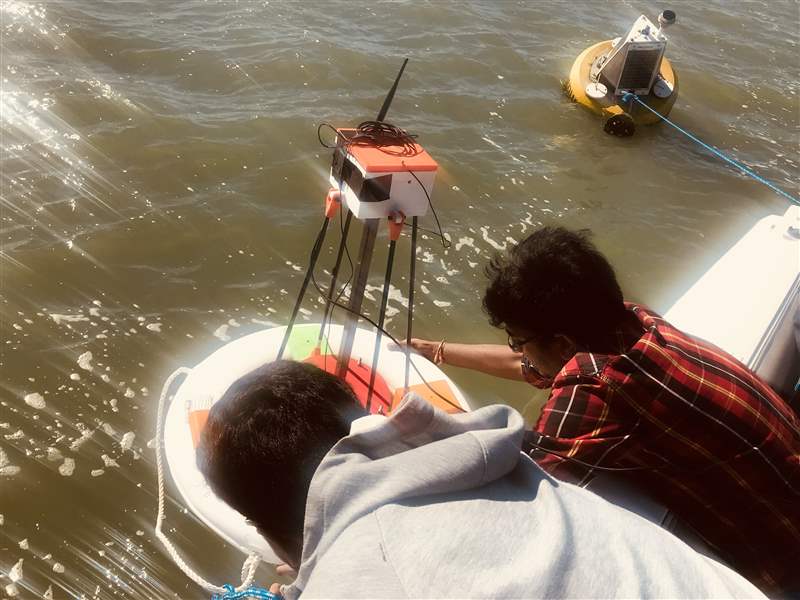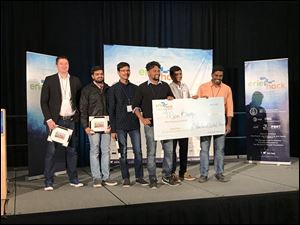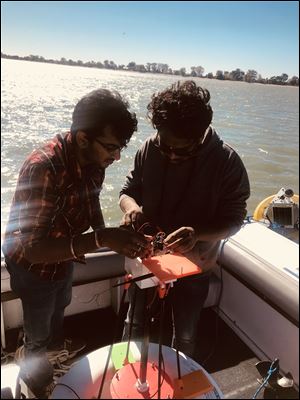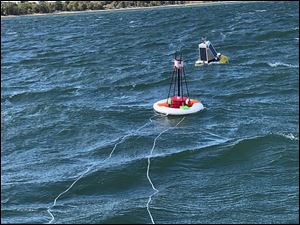
Wayne State team using buoys to detect Lake Erie pollutants
8/31/2018
Uday Praveen, left, and Sundeep Verma of the MicroBuoy team of Wayne State University launch a buoy into Lake Erie.
Call it a smart buoy.
A team of graduate students from Wayne State University in Detroit has developed a more efficient way to detect contaminants in Lake Erie in an ongoing effort to clean the water.
By putting in-house manufactured sensors inside a buoy that can instantly read and send data, the Wayne State team, MicroBuoy, captured the top prize at the 2017 Erie Hack Water Innovation Summit in Cleveland.
The Erie Hack competition, which included $100,000 in prizes, unites coders, developers, engineers, and water experts to generate enduring solutions to Lake Erie’s biggest challenges, such as the algal blooms that have been appearing there in recent years. Algal blooms are fed by excessive nutrients in the water such as phosphorus and nitrogen, and while these nutrients themselves aren’t harmful, the blooms they create sometimes generate microcystins, or cyanoginosins, which are toxic.

The MicroBuoy team from Wayne State University accepts its award after winning the top prize at the Erie Hack Water Innovation Summit in 2017.
The Wayne State team received $40,000, along with $10,000 support services to try and commercialize its invention. Teams from places all around Lake Erie (Ohio, Michigan, New York, and Canada) competed.
Nirul Masurkar, 31, and Sundeep Varma Gottumukkala, 26, and Uday Praveen, 28, all of India, were the Wayne State graduate students on the team led by Dr. Leela Arava, associate professor of mechanical engineering. Adding another team member in collaboration with the University of Buffalo for a national competition, MicroBuoy won the Technology Innovation Award and a $15,000 cash prize plus supportive services at the Internet of H2O water innovation competition, hosted by the Cleveland Water Alliance, in Port Clinton.
“Most of the commercial sensors used are not that sensitive,” Masurkar said. “We use a nano-material sensor which can detect the data within microseconds.”
MicroBuoy uses aquatic sensor technology to make real-time assessments of water quality, including levels of phosphorus and nitrogen. The device contains nano-sized batteries that can be recharged with solar energy. The speed of getting results from Lake Erie was an essential part of the competition.
“They take water samples from the lake and take them back to the lab,” Gottumukkala said. “This is tedious and time-consuming. With our buoy, you can remotely see the information on an app from a phone or another device. This will save a lot of time and money.”

Sundeep Verma Gottumukkala, left, and Nirul Masurkar of the Wayne State MicroBuoy team work on a buoy before it is placed in Lake Erie.
There is no consensus on what causes the algal bloom in Lake Erie and there is no magical solution. It has evolved over the decades and continues to change. But it is clear that there is no single cause with multiple factors contributing — agriculture, industry, stormwater runoff, wastewater, climate, and infrastructure. The Michigan Cleaner Lake Erie Through Action and Research (MI CLEAR) is a unique partnership of conservationists that came together last year to improve the long-term water quality of the Western Lake Erie Basin. Through open discussion among regional leaders, a coordinated perspective to existing efforts and actions that bring meaningful change, MI CLEAR complements the Erie Hack competition’s attempt to find a solution to the blooms.
Wayne State’s winning team was had diverse backgrounds of study.
“They all have expertise in different areas — science, electronics, developing software,” Arava said. “Another was good at building the device.”
Masurkar said one inspiration for the team to improve Lake Erie water quality was after the water contamination outburst in Flint, Mich.
Masurkar worked on developing high-resolution sensors. He also worked on fabricating high-powered miniaturized batteries that can make in-house sensors autonomous. Gottumukkala worked on programming communication between the sensor and hardware and designed the power management unit for the buoy to minimize the power consumption while transmitting data from sensor to substation. To ensure sturdy encapsulation, Praveen was in charge of making the buoy robust and waterproof.
“We thought the Erie Hack competition would be a perfect platform to bring our lab research work into the real work,” Masurkar said.

Aquatic sensor technology to access water quality in real time is used in buoys developed by the MicroBuoy team of Wayne State University.
Arava emphasized the importance of why getting water quality test results sooner is better.
“With the old system you might drink bad water for at least a day or two,” he said. “The damage is done. That is what we can prevent — keeping people from using bad water.”
The team anchored three buoys in Sandusky Bay for the competition. One was near the water intake where a traditional buoy from the National Oceanic and Atmospheric Administration (NOAA) was already being used.
“We deployed our buoy which has a phosphorous sensor,” Masurkar said. “They found our buoy was giving almost the same results as the lab. The second buoy was near the beach where most of the phosphorous was coming from. The third one was out in the lake. The buoys are also able to communicate with each other so we can find out the condition of the pollutant.”
The Wayne State team not only demonstrated the feasibility of using the buoys but also showed data can be received 10 miles from the beach.
Now, the team has formed a company named MicroBuoy Inc. and is hoping to have the device manufactured for widespread use. “We knew there was sensor technology for other things,” Arava said. “Also the software side has had so much evolution. Lakes are so vibrant and the dynamics change all the time. We thought there should be a spontaneous detecting system.”
Michigan Cleaner Lake Erie Through Action and Research (MI CLEAR) is a partnership working to improve Lake Erie and water quality of the Western Lake Erie Basin. The goal is to improve the long-term water quality through open discussion among regional leaders, support research that builds an understanding of science around water quality issues, and boost actions that bring meaningful change.
For more details about MI CLEAR, visit facebook.com/MIClearPartnership.